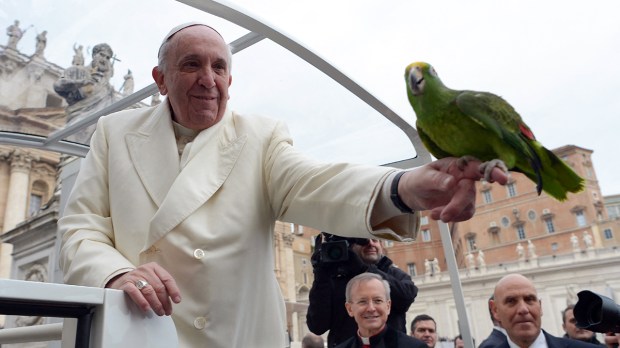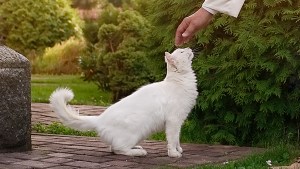It’s March 13, 2013. Journalists from all over the world have their eyes riveted on the Sistine Chapel’s chimney in search of the famous white smoke. Cardinals from all over the world have been deliberating for more than 20 hours now. Suddenly, at about 4:30 p.m., a white seagull lands on the cap of the red copper pipe. The white bird is quickly replaced by a second, slightly larger one. From its holy perch, the animal seems to look down on the crowd.
“The Holy Spirit is arriving at the conclave,” jokes a journalist on his Twitter account. That’s all it takes for the Vatican to make the bird the mascot of this election. Within minutes, a Twitter account (@SistineSeagull) is created and, in no time, nearly 4,000 people subscribe. The social network “tweets” endlessly.
Is the presence of this bird a few hours before the announcement of the election of Pope Francis, a lover of Creation and author of the famous encyclical Laudato si’, pure chance? Some are amused by the coincidence. On the evening of March 13, 2013, AICA, a Catholic news agency from the pope’s homeland, establishes a very serious link between the bird and Bergoglio. The bird of the conclave is a seagull of the species Larus argentatus, the Argentine media argues, explaining that the term argentatus refers to the name of the country of origin of the 266th pope.
The dove, sign of the election
This episode, which brings a smile, cannot help but remind us of the link—completely proven this time—that exists between the popes and a much more noble bird: the dove. In his Ecclesiastical History, Eusebius tells how, in the 3rd century, Pope Fabian was chosen by this biblical bird to lead the Church. “Suddenly, a dove descended from Heaven and landed on [Fabian’s] head, (…) reproducing the descent of the Holy Spirit on the Savior in the form of a dove,” the historian writes, before adding, “whereupon all the people (…) shouted that he was worthy, and without any delay (…) he was placed on the episcopal seat.”
Fabian, a simple man from the countryside, is not the only man providentially elevated to the rank of pope in this way. In his book The Bestiary of the Pope (“Il bestiario del papa”), Agostino Paravicini Bagliani explains that, according to various sources, St. Severus, Polycarp, and possibly Zephyrin may have been designated by this same means. The Italian also points out that the accounts of conclaves mention the descent of the bird of the Holy Spirit on the occasion of unexpected elections—those of simple men or of those still foreign to the world of Rome.
The dove is also the symbol of a well-known pope: Gregory I, known as “The Great.” In his 8th-century biography of the saint, the monk Paul the Deacon recounts the origins of this association. A man spying on Gregory as he dictated his commentary on Ezekiel is said to have seen one of these sacred birds fluttering over the shoulder of the 64th pope. When he stopped dictating, the animal would put its beak between his lips to suggest a new comment. From pope to pope, the dove became the symbol of the Church and the papacy. Its multiple representations in St. Peter’s in Rome—no less than 500—attest to this.
The eagle, symbol of pontifical power
However, the bird of peace is not the only one to have taken over the walls of the city of Rome. In a different tone, the 13th-century historian Gilles of Rome used the eagle to define the function of the pope. According to him, this majestic bird clearly represents the symbol of the pontifical power over the universal Church. Able to protect “everything” thanks to its large wings, the eagle is “full of feathers, that is to say, of virtues,” and is thus the likeness of the Sovereign Pontiffs, he says.
Then, better known for its chatter than for its wisdom, the parrot also has had a place of honor with the popes. The story of friendship between this colorful animal and the popes began in the 11th century, when a ruler—probably Stephen I, King of Croatia and Dalmatia—sent a parrot to Pope Leo IX. The animal was able to repeat not only “I am going to the pope” but also the name of the pontiff, Leo. When the latter was tired and discouraged, the bird gave “new inner strength” to this pontiff of foreign origin, who reigned under difficult circumstances.
In the 13th century, the rediscovery of ancient Rome and its symbolism reinforced the interest of the Curia in this imperial animal. However, it was not until the Avignon period that the recurrent presence of birds with the pontiffs, even in their bedrooms, became notable. The last two popes of Avignon—Urban V and Gregory XI—returned to Rome with a parrot. From then on, the tradition of the “pope’s parrot,” an animal carried on the trips of Peter’s successor, continued until the 15th century.
The “Parrot Room”
In 1420, a document reports for the first time the existence of a “parrot room” in the Apostolic Palace, in which the pope gathered the cardinals in consistory and prepared himself before participating in solemn ceremonies. A sort of boundary between private and public space, this room was also used to receive ambassadors.
Under Leo X, the symbolism of the parrot in the Vatican reached its peak: to honor the Medici popes, the painter Raphael depicted St. John the Baptist looking at a small South American parrot. Taking up the Roman and medieval tradition that depicted the bird announcing the emperor, the artist associated the Baptist with a parrot to announce the pope as the representative of Christ on Earth.
Pius XII’s canaries
Much later, Pope Francis brought birds back into the picture during an audience in 2014. As he passed through the crowd in St. Peter’s Square, a parrot came to rest on his finger. The legendary photo went around the world and elicited affectionate comments. As a good spiritual son of St. Francis, the 266th pope said to the owner of the animal: “It’s a very beautiful gift of God.” This tenderness for the bird did not prevent him from warning the faithful against the risk of praying like parrots, that is, mechanically.
In the recent history of the papacy, the successor of Peter who was fondest of birds was Pius XII. The World War II pope had a special affection for a small canary that he liked to have perched on his finger. And if the members of the Roman Curia could sometimes make fun of this little bird—a strange pet for a pope—his secretary, Sister Pascalina, took great care of this bird that brought comfort to this man with such a heavy weight on his shoulders.


